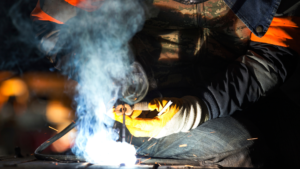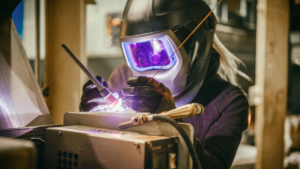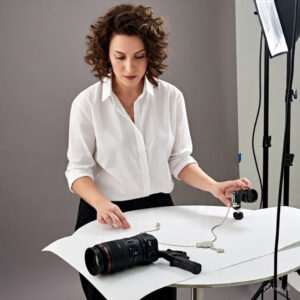How to use a Welder for Beginners – Quick Guide

Introduction
How to use a Welder for beginners ?
Welding is a versatile process that is used for joining metal pieces together permanently. Welders are useful tools that are a must-have for anyone who works with metals. They come in different brands, models, and sizes and can be used for various welding applications.
If you are a beginner welder or have never used a welder before, it can be a daunting task figuring out how to use it. However, with the right guidance, welding can be an enjoyable and fulfilling experience. This article will provide useful tips on how to use a welder for beginners.
Understanding the Different Types of Welders
There are different types of welders available in the market. The most popular types are stick welders, MIG welders, and TIG welders. These three types of welders have their distinctive features and are used for various applications.
Stick Welder: This type of welder uses a consumable electrode that is coated with flux. The flux produces a protective shield which prevents the weld from getting contaminated. Stick welders are useful for welding materials such as steel, stainless steel, and cast iron.

MIG Welder: This type of welder uses a spool of wire that is fed through a gun. The wire is melted and fed into the weld pool, where it fuses with the workpiece. MIG welders are suitable for welding materials such as stainless steel, mild steel, and aluminum.
TIG Welder: This type of welder uses a tungsten electrode to produce the weld. The welder also uses a filler wire that is fed manually into the weld pool. TIG welders are useful for welding materials such as aluminum, stainless steel, and magnesium.
Safety Precautions
Welding can be a dangerous process, and it is crucial to take the necessary safety precautions while using a welder. Here are some safety tips that you should follow while using a welder:
- Wear Protective Clothing: Welding produces a bright light that can damage your eyesight permanently. Therefore, you should wear welding goggles, a welding helmet, or a welding face mask while welding. Protective clothing such as a welding jacket, gloves, and boots can also protect you from electrical shock and burns

- Keep Your Work Area Clean: Welding produces sparks and debris that can be a fire hazard. Therefore, you must clear your work area of flammable materials such as chemicals, paper, and sawdust.
- Use Proper Ventilation: Welding produces toxic fumes and gases that can be hazardous to your health. Therefore, you should work in a well-ventilated area or use a welding exhaust system to remove the fumes.
- Keep Flammable Materials Away: Flammable materials such as gasoline, propane, and butane can ignite easily when exposed to welding sparks. Therefore, you should keep them away from your work area.
Preparing Your Welder
Before using your welder, you must prepare it properly. Here are the steps you should follow:
- Choose the Right Type of Welder: As mentioned earlier, there are different types of welders available. You should choose the right type of welder that is suitable for your welding needs.
- Connect Your Welder to a Power Source: Welders require a lot of power to function. Therefore, you should connect it to a power source that can supply the required voltage and amperage.
- Set the Welding Parameters: Different welding applications require different welding parameters such as voltage and amperage. You should consult the user manual for your welder to know the appropriate welding parameters for your welding needs.
- Load the Welding Wire: If you are using a MIG welder, you should load the welding wire into the welding gun. Ensure that the tension settings are correct to avoid wire feed problems.
- Test Your Welder: You should test your welder before using it to ensure that it is working correctly. You can do this by running a test weld on a scrap metal.
Welding Techniques
There are different welding techniques that you can use while welding. Here are some of the most common techniques:
- Stick Welding: The stick welding technique is used for welding thick metals or metals that have a rough or dirty surface. This technique involves striking an arc between a consumable electrode and the workpiece. The electrode produces a molten pool, which fuses with the workpiece to form a weld.
- MIG Welding: MIG welding is a straightforward and versatile welding technique that is suitable for welding metals such as steel, stainless steel, and aluminum. This technique involves feeding a spool of wire through a gun and melting it into the weld pool to form a weld.
- TIG Welding: TIG welding is a precise and clean welding technique that produces high-quality welds. This technique involves striking an arc between a tungsten electrode and the workpiece. The welder then manually feeds a filler wire into the weld pool, which fuses with the workpiece to produce a weld.
Set and Adjust the Welding Machine
Once you’ve determined the right welding process, it’s time to set and adjust the welding machine. Start by selecting the appropriate wire size, amperage, and voltage, depending on the metal thickness. Follow the manufacturer’s instructions to adjust the wire feed speed, gas flow rate, and other vital settings.
Welding techniques vary depending on the type of metal and the welding process used. For instance, MIG welding requires a push or drag technique, while TIG welding requires a circular or weaving motion. Therefore, choose the right welding technique and practice it until you master it.
Weld the Metal
Once you’ve set up the welding area, prepared the metals, and adjusted the welding machine, it’s time to start welding. Start by holding the welding gun or torch at the proper angle and distance. Move the gun or torch in a steady and consistent motion to create a uniform bead. Watch out for any signs of overheating, such as discoloration, and adjust the settings accordingly.
Inspect and Clean the Weld
After welding, inspect the welds for any cracks, gaps, or porosity. Use a wire brush to clean off any slag or debris that may have accumulated on the weld. Additionally, use a grinder to smooth out any rough edges.
Practice and Patience
Welding takes time and practice to master. Therefore, don’t rush through the process or become discouraged if you don’t get it right the first time. Keep practicing, experimenting with different techniques and settings until you achieve a satisfactory result.
Conclusion
In conclusion, welding can be a highly rewarding hobby or profession that requires patience, practice, and attention to safety. Before working with a welder, it is important to select the appropriate equipment, materials, and work environment, as well as to carefully follow all safety guidelines.
By mastering the basics of welding, beginners can gain confidence and develop their skills to create a wide variety of projects and products. With dedication, determination, and a willingness to learn, anyone can become a successful welder and enjoy the many benefits that this versatile craft has to offer.

With a degree in Electrical Engineering and years of hands-on experience in the tech industry, passionate to provide readers with insightful reviews. From smartphones and laptops to smart home devices and emerging technologies, he navigates the ever-evolving tech landscape, offering in-depth analyses and honest opinions.

![3d_printed_art_01[1]](https://techreviewly.com/wp-content/uploads/2025/08/3d_printed_art_011-300x225.jpeg)
![a_women_wearing_a_smart_watch_01[1]](https://techreviewly.com/wp-content/uploads/2025/08/a_women_wearing_a_smart_watch_011-300x169.jpeg)






